| Type of monument |
: Type II Temple |
| Location |
: Northwest of Kyanzittha Umin near the bank of
Ayeyarwaddy River |
| Region |
: Nyaung U & Wetkyi-In |
| Built by |
: King Anawrahta |
| Date |
: A.D 1076 |
| Monument Number |
: 1 |
| Photo Gallery |
: View 35 Photos |
Shwezigon was built as the most important reliquary shrine in
Bagan, a centre of prayer and reflection for the new Theravada faith
King Anawarahta had established in Bagan.
The pagoda is standing between the village of Wetkyi-in and Nyaung
U. It is a beautiful pagoda and was commenced by King Anawrahta but
not completed until the reign of King Kyanzittha (1084-1113). King
Kyanzittha was thought to have built his palace nearby.
It was known that, the Shwezigon was built to enshrine one of the
four replicas of the Buddha tooth in Kandy, Sri Lanka, and it was to
mark the northern edge of the city. The other three tooth replicas
were enshrined in other three more pagodas. The second tooth replica
went to Lawkananda Pagoda, a smaller pagoda to the south end of the
city. Then the third replica went to Tan Kyi Taung (Tant Kyi Hill)
Pagoda, a pagoda on the western bank of the Ayeyarwady River.
The last one was enshrined into Tu Yuan Taung (Tu Yuan Hill), a
pagoda on the summit of a hill 32 km to the east.
Note : Nowadays, there is a legend saying that if one visit those
all four tooth replicas in a day, it can bring one prosperity and
luck.
Exterior view:
The pagoda's graceful bell shape became a prototype for virtually
all later pagodas all over Myanmar. The gilded pagoda sits on three
rising terraces. Enameled plaques in panels around the base of the
pagoda illustrate scenes from the previous lives of the Buddha, also
known as the 550 Jatakas. At the cardinal points, facing the terrace
stairways, are four shrines, each of which houses a four-meter-high
bronze standing Buddha. These bronze Buddha images are known to be
the last survived images of the ancient time. Their left hands
exhibit the vitarka or 'exposition' mudra while the right hands are
held palm outward, fingers straight up, portraying the gesture of
abhaya or 'no fear'.
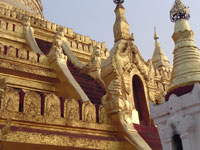
stairways to the zedi
|
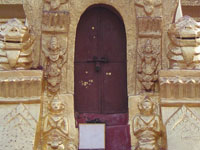 |
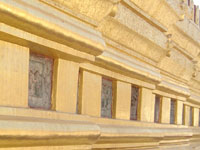
Glazed plaques of the jatakas
|
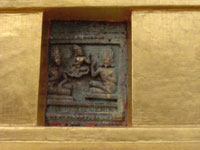 |
A10-cm circular indention in a stone slab near the eastern side of
the pagoda was filled with water to allow former Myanmar monarchs to
look at the reflection of the hti (or the tope umbrella of the
pagoda) without tipping their heads backward (which might have
caused them to lose their crowns).
Visitors can view the bejeweled hti through a telescope. Surrounding
the pagoda are clusters of zayats (rest houses) and shrines, some of
them old, others more modern, though none of them are original.
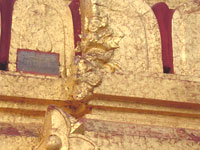
Thagyamin figure
|
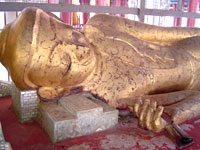 |
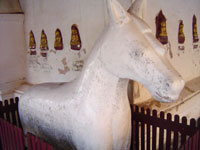
the magic horse of King Kyanzittha
|
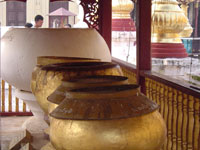 |
In addition to ranking as one of the oldest pagodas in Bagan,
Shwezigon is known as the site where the 37 pre-Buddhist nats (the
spirits) were first officially endorsed by the Myanmar monarchy.
Images of the 37 nats can be seen in a shed to the southeast of the
platform. At the eastern end of the shed stands an original stone
statue of Thagyamin (Sakra), king of the nats and a direct
appropriation of the Hindu god Indra. This is the oldest known
free-standing Thagyamin figure in Myanmar. Flanked by tigers
representing her forest home, another small shrine in the
south-eastern corner of the grounds is reserved for Mae Wunna, the
guardian nat of medicinal roots and herbs, near the region.
nats
Tips : Entry fees are taken at the entrance and also cameras and
videocams have to pay to carry around and take pictures.
walkway to the shwezigon pagoda